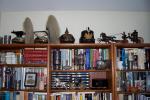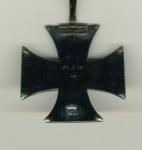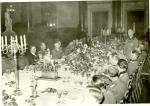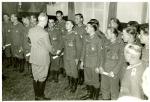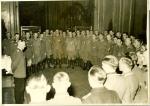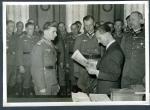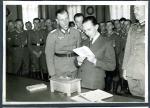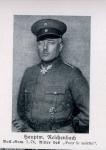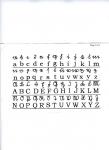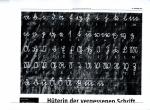
Bernhard H.Holst
For Deletion-
Posts
1,481 -
Joined
-
Last visited
Content Type
Profiles
Forums
Blogs
Gallery
Events
Store
Everything posted by Bernhard H.Holst
-
Hello Christer. At the beginning of my reading up on the German aspects of both WW I and WW II I was somewhat surprised to see the fairly large number of service members of the German Navy whose origin lay in "inner" Germany far from access to saltwater. But there seems to be some attraction to serve at sea for people from everywhere. But as Rick pointed out probably serving in one of the many units of the Marine Korps in Flanders. Bernhard H. Holst
-
Marching to the Beat of a 9 Bars KGL MGS Medal
Bernhard H.Holst replied to a topic in Napoleonic Wars
Hello readers: Peter pointed out the combat of Garcia Hernandez in some details , for which I thank him). Besides the Koenigs-Ulanen Regt.(1.Hann.) Nr. 13 wearing the battle distinction "Garcia Hernandez" in their Tschapka bandeau, the 2. Hannoversches Ulanen Regt. Nr.14 also wore this distinction as well as "Peninsula" and "Waterloo". BTW: to this day the Hanover region ( now called Lower Saxony) has a well deserved reputation of raising excellent horses and good riders. Bernhard H. Holst -
Marching to the Beat of a 9 Bars KGL MGS Medal
Bernhard H.Holst replied to a topic in Napoleonic Wars
Hello readers: Here are the battle inscriptions for the pictured head gear: - Ulanen 13 Koenigs Ulanen (Hann)): Peninsula, Waterloo and Garcia Hernandez. - Fus.73 (Hann.) Peninsula and Waterloo, (also Gibraltar cuff title); - Jg.10 (Hann.) : Peninsula,Waterloo and Venta des Pozo, (also Gibraltar cufftitle); Nearly all the other Hanoverian and also Brunswick formations had distinctions similar to these, otherwise battle or campaign bandeau inscriptions were rarely seen. Bernhard H. Holst -
Marching to the Beat of a 9 Bars KGL MGS Medal
Bernhard H.Holst replied to a topic in Napoleonic Wars
Hello: I am of course prejudiced being from the former Kingdom of Hanover but believe as Rick already pointed out that those former members of the Army of Hanover then disbanded by Napoleon and new volunteers from Hanover of which the majority of the KGL consisted were patriotic men who braved some considerable obstacles and risked life and limbs to reach England to join the KGL. The KGL earned a number of battle honors later incorporated by the Hanoverian Army and later still restored by Emperor Wilhelm II. Here is a picture of the headgear of three Hanoverian formations so distinguished : second Tschapka is that of Hanover Koenigs Ulanen, Pickelhaube of Fus.Regt. 73 (Hann.) and lastly Tschako of Jg.Batl.10 (Hann.) All three have the Bandeau inscription Peninsula , Ulanen , Fuselier and Jaeger additional, different inscriptions referring to certain battles. Bernhard H. Holst -
Marching to the Beat of a 9 Bars KGL MGS Medal
Bernhard H.Holst replied to a topic in Napoleonic Wars
Hello Rick and Paul. Thanks for showing this incl. the name. I believe drummers in the British Army and consequently the Hanoverian Army were of a rather tender age. The KGL being more or less the successor of the Hanoverian Army probably carried on with that tradition. As to the spelling of names , Anglo clerks coping with those strange names in the 18oo's?? BTW: to get both my first and last names spelled right nowadays here in the USA ... Bernhard H. (Hermann) Holst -
Hello ccj: The book "Uniformen der Deutschen Infanterie 1888 bis 1914 in Farbe " by R.Herrmann, J, Nguyen and R. Bernert ( Uniforms of the German infantry 1888 to 1914 in color)from 2003 lists Bavaria as the only exception to the colors of the markmanship lanyards. When these lanyards were instituted by Emperor Wilhelm II in 1894 they were to bear the Imperial colors of Germany, Black, White and Red. However Bavaria used the Bavarian colors of white/blue while the grades' distinctions were identical. With the 5th class the rosettes had gold colored metal medallions displaying the cyphers of the reigning monarchs (Prussia, Wuerttemberg and Saxony) while Bavaria used their kingdom's heraldic insignia. As an aside: Bavaria was able to gain certain exceptions pertaining to their military when the 2nd German Reich was formed in 1871. I believe they maintained their own General Staff and War Ministry for example. Bernhard H. Holst
-
Hello; Here are the several decorations Maj. a.D.Justus Schirmer received during his military service with signals units or as staff officer . The document to both the 2nd and 1st classes of the Oldenburg cross was dated November 10, 1918 and makes reference of the officer being a member of the German Training Ship Association (Deutscher Schulschiffverein) and is the recipient of both Iron Crosses?? The mini chain mounted decorations include a Red Eagle Order for which the documents which came with the military estate and which are quite complete contain no certificate. Also our Rick Research could not find verification when told about this. Therefore I do not show the chain. Of note may be the I.C. 1st class maker LW and each corner having a slight "bump". I hope you enjoy the looks. Bernhard H. Holst
-
Friendly Fire, Vietnam 1951 - 1954
Bernhard H.Holst posted a topic in Modern Campaigns and Conflicts
Hello readers. For military personnel on the ground involved in active operations being fired on by the enemy is accepted. However receiving fire from one's friends is resented and more so when casualties occur. During a recent search for members of my former regiment who lost their lives during the French conflict in Vietnam on the official French site listing the fatal losses there (SGA Memoire des Hommes) I stumbled across the listing of Trooper NGUYEN, Xuan Hung, born in 1933, 1er Regiment de Chasseurs, killed by friendly artillery fire on 5 December, 1952 . This triggered my memory of incidents while on active duty in the north of Vietnam 1951 to 1953 and again from early 1954 to the end of hostilities with the 1er REC. Some notes kept by me reveal some instances of friendly fire losses: -Friendly losses caused by French aviation support: During an operation in February, 1952 a battalion based on Haiduong and operating with us lost a captain and three soldiers from a missed drop of Napalm. Anyone having witnessed the bodily damages inflicted by Napalm... -Friendly losses caused by French Navy fires: May, 1953 Company Quenican (sp), placed in ambush position on the bank of the River Day, also the route Ninh Binh - Gin Kauh was fired on during the night by an LSSL or LCI, (heavily armed shallow draft landing vessels designed for fire support and only limited transport). This company had operated with us on a number of occasions and consisted of mainly Vietnamese personnel with French colonial cadres. It lost that terrible night seven dead and 14 wounded. -Friendly losses by French artillery fire. The causes unknown but could be defective ammunition, worn barrels, incorrect fire direction by the advanced observers accompanying formations or incorrect relay of fire commands. Also sometimes friendly infantry was unable to respect the established safety distances between enemy locations and own positions due to being nailed down in place. December 1952 a mounted infantry company of the 1er Chasseurs endured friendly artillery fire while on foot and operating with us. The losses were one killed and two or three wounded. While this writer was the company radio operator he only saw the company commander Capitaine ( later colonel) Andre Viard nervous only once and that was when he observed the movement of some of our company's elements in wet rice paddies. Artillery fire was to be laid down on the far flanks of the advance but the first six guns salvo landed squarely only a few meters in front of our spread out men.Captain Viard grabbed the radio combination micro/earphone and shouted to stop the firing because it was about to kill his men. The firing stopped , not to resume again. With all 6 rounds coming down like this together one wonders. One other friendly fire incident took place either in May or June 1953 when elements of the Commandos 24 and 42 encountered each other at night. The ensuing firefight left one dead and one wounded. We were told that only the use of tracer rounds of the submachine guns when noticed caused a stop because the enemy did not use these with that weapon. On dit ( rumors) had it that the authority issuing the orders messed up the unit numbers thus causing both commandos hitting the same objective at the same time. Such is war ! Bernhard H. Holst -
Hello readers: Here are the three others with the group which seem to cover the same delegation at different functions. The first one again shows General v.Hase addressing the assembly which here includes another general (facing, at left). This seems at a dinner. Some party functionary addressing the delegation: I believe the composition of the delegation can be seen in the last two pictures. Bernhard H. Holst
-
Hello Rick. The photos have no indication of photographer, control number or similar. However the location as are the ones of the other photos lead me to think an official photographer was at work. Besides Dr. Goebbels being the Reichsminister fuer Volksaufklaerung und Propaganda and Gauleiter and held other jobs certainly had the services of photographers. In the substantial publications I have seen, I do not recall any photos such as these. They may have been meant as memento for the participants only. By the way I could only make out three Knights Cross recipients, other personnel present range to Iron Cross 2nd class and such. Apparently some gifts or similar were given to Goebbels who appears interested. Bernhard H. Holst
-
Hello readers: The military estate of Knights Cross recipient Oblt. Otto Ude which is in my custody, contains several photos of which I have attached two. They do not contain any notes as to time or place but must have been taken somewhere in Berlin after January, 1943, the date of bestowal of the Knights Cross to the then Oberwachtmeister Otto Ude. The name of the officer with the Knights Cross near Dr. Goebbels in the one photo is unknown. The N.C.O. with the K.C. in the other is Owm. Ude. However the general looking on in both photos is Gen.Lt. Paul v. Hase, a participant of the 20th of July, 1944 coup attempt on Hitler and executed in August, 1944. One wonders what went through his mind at this time?? Perhaps of note is the delegation mix of more and less highly decorated personnel, a clever move by the organizers of such visits, I think. Bernhard H. Holst
-
Grammatikfrage
Bernhard H.Holst replied to Dave Danner's topic in Deutsche Kaiserreich: Man spricht Denglish
-
French soldiers remains found at Verdun
Bernhard H.Holst replied to Bernhard H.Holst's topic in The Great War 1914 to 1918
Christophe, thank you for the link. Bernhard H. Holst -
Hello readers. Le Figaro newspaper of June 1, 2013 has a report of the discovery of a number of remains of French soldiers who died during the Battle of Verdun in 1916. It is stated that German tourists found a human bone in the area of Fleury-devant Douaumont and alerted authorities. Subsequently the remains of some twenty soldiers were unearthed. It appears that in one instance a first aid post was destroyed by German artillery fire. Two watches found had both stopped at 11:06. Seven identity discs found already lead to the identification of remains. A member of the French remembrance facility nearby, Ossuaire de Douaumont indicated to the newspaper that an average of three to four remains are discovered each year and that such a rather high number discovered is rather rare. In 1991 the remains of the French author Alain Fournier with twenty of his comrades who lost their lives in 1914, were found. These soldiers will now rest with many thousands of their comrades at Verdun or perhaps reclaimed by their families and then find their final resting places near home. May they now rest in peace. A reference book on French orders and other decorations lists Fleury-devant Douaumont as "Mort pour la France" together with some few other municipalities. Fleury was never rebuilt. Interesting to read readers comments. Bernhard H. Holst
-
to # 64: Addressed to: An Fraeulein Marie Flaenig in Nangdorf b. ( meaning bei or near) Zwickau Muetzen Grund. Text: 31. 12. 1914 Liebe Marie. Ich gratuliere Ihnen zum neuen Jahr und wuensche Ihnen viel Glueck und Gesundheit nebst Ihren lieben Eltern das es Ihnen bei der schweren Zeit recht gut gehen moege. Gruessen Sie bitte die Famililie Moeger unser Sohn ist seit acht Tagen wieder zurueck von ??? wegen Krankheit. Es gruesst Ihnen freundlich Franz Richter und seine Frau nebst Sohn. Schreiebe bald wieder ( last two words in margin) Inscription on face of postcard " Als er wiederkam" For those who would like a summary in English: the card is addressed at an acquaintance , expressing new year well wishes in these difficult times. The writer's son has returned home because of illness. He ill write again soon. Picture inscription says " When he returned" Bernhard H. Holst
-
Hello: Attached picture and comment is from the WW I regimental history of Inf.Rgt. (1.Hann.) Nr. 74 and shows Hptm.(later Major) Reichenbach, commander of I./Inf.Rgt.74 and recipient of the Pour le Merite with date of April 21,1918. He distinguished himself and the troops under his command during the March, 1918 German offensive when the Somme River and canal was crossed. The collar insignia seem to indicate Freikorps service following the end of the war. Bernhard H. Holst
-
Hello readers. Here is what I hope may be of some help to those of us who struggle with Suetterlin script. I believe Rick Research has posted a similar template some time ago. The designer of this script was Ludwig Suetterlin (umlaut u ), a teacher and graphic technician who lived from 1865 to 1917 and who developed this script in the early 1900's. It was introduced in the State of Prussia in 1924 and from 1930 in most of the other German states. It was to make the learning of writing easier. It has come to my attention recently that during the 1930's this script was formally forbidden by the then National Socialist Government . The pertinent law has not been rescinded by the current government. This writer not only learned to write on a slate but also learned and used Suetterlin for at least two years until it was abolished by law. Following are two templates to chose from: Bernhard H. Holst
-
Famous British POWs
Bernhard H.Holst replied to azyeoman's topic in Great Britain: Research, Documentation & History
Hello : Fascinating reading bringing back some personalities of whom I had knowledge before but dimmed by time. Thanks for this elaborate posting which I enjoyed greatly reading on an early morning. Bernhard H. Holst -
Hello John. This person served first in a "standby" medical unit which could be deployed at short notice and late 1944 transferred to another, also medical unit. His location was in western Germany , an area singled out for frequent air raids, day and night due to heavy industrial facilities manufacturing war material. Papers show issued equipment and clothing. A register listing frequent leaves, primarily to recover health ( Erholungsurlaub), probably needed after frequent deployments during/after air raids. No information re. grounds for decoration. I hope this helps, Bernhard H. Holst
-
EK 1870 "you can keep it..."
Bernhard H.Holst replied to Chris Boonzaier's topic in Germany: All Eras: The Iron Cross
Chris: Family could purchase those decorations which were to have been returned upon the death of the recipient per the pertinent statutes which were usually delivered together with the decoration. There may have been certain exceptions to the rule that a family was allowed to keep the item without any cost to them. 1813 Iron crosses were to be returned but not 1870/71. Memory is at work here , not as good as it used to be however. Bernhard H. Holst -
EK 1914 Some Eye Candy
Bernhard H.Holst replied to Chris Boonzaier's topic in Germany: All Eras: The Iron Cross
Hello Chris: Richtkanonier , I believe is called a gun pointer. Nice documents, all incl. the Saxon one. Bernhard H. Holst

